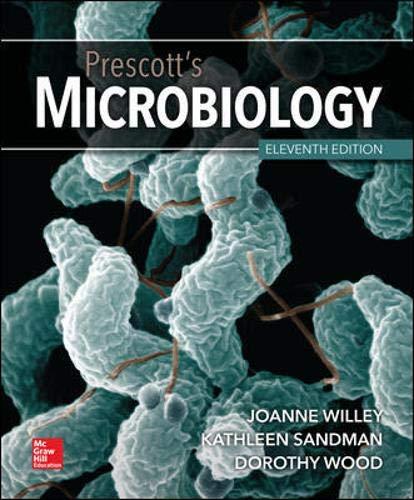
Prescott's Microbiology
11th Edition
ISBN: 9781260211887
Author: WILLEY, Sandman, Wood
Publisher: McGraw Hill
expand_more
expand_more
format_list_bulleted
Concept explainers
Question
Chapter 18, Problem 2AL
Summary Introduction
EMSA stands for electrophoretic mobility shift assay and it is the most common method used to study DNA-protein interactions. This method is also termed as a gel shift assay. This is because the DNA binding protein is added to the purified target DNA mixture and its mobility is slowed down using an agarose gel. The DNA-protein complex is found to be shifted to a higher molecular weight when compared to the DNA without the protein. Usually, the magnitude of the shift is related to the DNA-protein ratio. Thus, the largest shift would be seen when sufficient protein is added.
Expert Solution & Answer
Want to see the full answer?
Check out a sample textbook solution
Students have asked these similar questions
What is behavioral adapt
22. Which of the following mutant proteins is expected to have a dominant negative effect when over-
expressed in normal cells?
a. mutant PI3-kinase that lacks the SH2 domain but retains the kinase function
b. mutant Grb2 protein that cannot bind to RTK
c. mutant RTK that lacks the extracellular domain
d. mutant PDK that has the PH domain but lost the kinase function
e. all of the above
What is the label ?
Chapter 18 Solutions
Prescott's Microbiology
Ch. 18.1 - MICRO INQUIRY What is the function of the 3-OH...Ch. 18.1 - MICRO INQUIRY Why is it important that identical...Ch. 18.2 - MICRO INQUIRY Which step (or steps) in this...Ch. 18.2 - Retrieve, Infer, Apply Why is the Sanger technique...Ch. 18.2 - Retrieve, Infer, Apply Explain the difference...Ch. 18.2 - Retrieve, Infer, Apply Why does reversible chain...Ch. 18.2 - Prob. 4CCCh. 18.2 - Retrieve, Infer, Apply Suggest a medical and an...Ch. 18.3 - Retrieve, Infer, Apply NGS techniques are...Ch. 18.3 - Retrieve, Infer, Apply Examine figure 18.8. How...
Ch. 18.4 - Prob. 1MICh. 18.4 - Prob. 1CCCh. 18.4 - Prob. 2CCCh. 18.4 - Prob. 3CCCh. 18.5 - Figure 18.12 Metabolic Pathways and Transport...Ch. 18.5 - Prob. 2MICh. 18.5 - Prob. 3MICh. 18.5 - Prob. 1CCCh. 18.5 - Retrieve, Infer, Apply How might the following...Ch. 18.5 - Retrieve, Infer, Apply Compare and contrast...Ch. 18.5 - Retrieve, Infer, Apply Why does two-dimensional...Ch. 18.5 - Retrieve, Infer, Apply What is the difference...Ch. 18.5 - Retrieve, Infer, Apply Describe a ChIP-Seq...Ch. 18.7 - Prob. 1MICh. 18.7 - Retrieve, Infer, Apply Cite an infectious disease...Ch. 18.7 - Prob. 2CCCh. 18.7 - Prob. 3CCCh. 18 - Prob. 1RCCh. 18 - Prob. 2RCCh. 18 - Prob. 3RCCh. 18 - Prob. 4RCCh. 18 - Prob. 5RCCh. 18 - Prob. 1ALCh. 18 - Prob. 2ALCh. 18 - You are developing a new vaccine for a pathogen....Ch. 18 - Prob. 4AL
Knowledge Booster
Learn more about
Need a deep-dive on the concept behind this application? Look no further. Learn more about this topic, biology and related others by exploring similar questions and additional content below.Similar questions
- Can you described the image? Can you explain the question as well their answer and how to get to an answer to an problem like this?arrow_forwardglg 112 mid unit assignment Identifying melting processesarrow_forwardGive only the mode of inheritance consistent with all three pedigrees and only two reasons that support this, nothing more, (it shouldn't take too long)arrow_forward
- Oarrow_forwardDescribe the principle of homeostasis.arrow_forwardExplain how the hormones of the glands listed below travel around the body to target organs and tissues : Pituitary gland Hypothalamus Thyroid Parathyroid Adrenal Pineal Pancreas(islets of langerhans) Gonads (testes and ovaries) Placentaarrow_forward
- What are the functions of the hormones produced in the glands listed below: Pituitary gland Hypothalamus Thyroid Parathyroid Adrenal Pineal Pancreas(islets of langerhans) Gonads (testes and ovaries) Placentaarrow_forwardDescribe the hormones produced in the glands listed below: Pituitary gland Hypothalamus Thyroid Parathyroid Adrenal Pineal Pancreas(islets of langerhans) Gonads (testes and ovaries) Placentaarrow_forwardPlease help me calculate drug dosage from the following information: Patient weight: 35 pounds, so 15.9 kilograms (got this by dividing 35 pounds by 2.2 kilograms) Drug dose: 0.05mg/kg Drug concentration: 2mg/mLarrow_forward
- A 25-year-old woman presents to the emergency department with a 2-day history of fever, chills, severe headache, and confusion. She recently returned from a trip to sub-Saharan Africa, where she did not take malaria prophylaxis. On examination, she is febrile (39.8°C/103.6°F) and hypotensive. Laboratory studies reveal hemoglobin of 8.0 g/dL, platelet count of 50,000/μL, and evidence of hemoglobinuria. A peripheral blood smear shows ring forms and banana-shaped gametocytes. Which of the following Plasmodium species is most likely responsible for her severe symptoms? A. Plasmodium vivax B. Plasmodium ovale C. Plasmodium malariae D. Plasmodium falciparumarrow_forwardStandard Concentration (caffeine) mg/L Absorbance Reading 10 0.322 20 0.697 40 1.535 60 2.520 80 3.100arrow_forwardPlease draw in the missing answer, thank youarrow_forward
arrow_back_ios
SEE MORE QUESTIONS
arrow_forward_ios
Recommended textbooks for you
 Biology (MindTap Course List)BiologyISBN:9781337392938Author:Eldra Solomon, Charles Martin, Diana W. Martin, Linda R. BergPublisher:Cengage Learning
Biology (MindTap Course List)BiologyISBN:9781337392938Author:Eldra Solomon, Charles Martin, Diana W. Martin, Linda R. BergPublisher:Cengage Learning Biology 2eBiologyISBN:9781947172517Author:Matthew Douglas, Jung Choi, Mary Ann ClarkPublisher:OpenStax
Biology 2eBiologyISBN:9781947172517Author:Matthew Douglas, Jung Choi, Mary Ann ClarkPublisher:OpenStax Biology Today and Tomorrow without Physiology (Mi...BiologyISBN:9781305117396Author:Cecie Starr, Christine Evers, Lisa StarrPublisher:Cengage Learning
Biology Today and Tomorrow without Physiology (Mi...BiologyISBN:9781305117396Author:Cecie Starr, Christine Evers, Lisa StarrPublisher:Cengage Learning Human Heredity: Principles and Issues (MindTap Co...BiologyISBN:9781305251052Author:Michael CummingsPublisher:Cengage Learning
Human Heredity: Principles and Issues (MindTap Co...BiologyISBN:9781305251052Author:Michael CummingsPublisher:Cengage Learning
 BiochemistryBiochemistryISBN:9781305577206Author:Reginald H. Garrett, Charles M. GrishamPublisher:Cengage Learning
BiochemistryBiochemistryISBN:9781305577206Author:Reginald H. Garrett, Charles M. GrishamPublisher:Cengage Learning

Biology (MindTap Course List)
Biology
ISBN:9781337392938
Author:Eldra Solomon, Charles Martin, Diana W. Martin, Linda R. Berg
Publisher:Cengage Learning

Biology 2e
Biology
ISBN:9781947172517
Author:Matthew Douglas, Jung Choi, Mary Ann Clark
Publisher:OpenStax

Biology Today and Tomorrow without Physiology (Mi...
Biology
ISBN:9781305117396
Author:Cecie Starr, Christine Evers, Lisa Starr
Publisher:Cengage Learning

Human Heredity: Principles and Issues (MindTap Co...
Biology
ISBN:9781305251052
Author:Michael Cummings
Publisher:Cengage Learning


Biochemistry
Biochemistry
ISBN:9781305577206
Author:Reginald H. Garrett, Charles M. Grisham
Publisher:Cengage Learning
Bacterial Genomics and Metagenomics; Author: Quadram Institute;https://www.youtube.com/watch?v=_6IdVTAFXoU;License: Standard youtube license